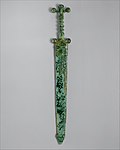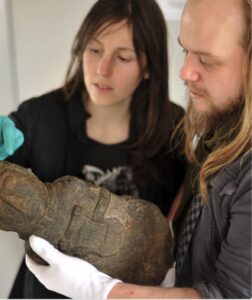Join Augustin, Alex, Lisa and the whole ArkeoTopia team to discover additional resources for step 6.4 in My Archaeology Book on the analysis of archaeological remains in the laboratory through experiments.
Step 6.4 – In the Lab
Experimenting to Test a Hypothesis
Corresponding pages in MAB1 and MAB2
MAB 1 p. 29 and MAB 2 p. 35
More about this step’s reference artifact
 The drawing in My Archaeology Book titled Experimenting to Test a Hypothesis was inspired by a Celtic sword from the Iron Age. This sword helps to illustrate a well-known method in science: experiment procedures from the experimental method.
The drawing in My Archaeology Book titled Experimenting to Test a Hypothesis was inspired by a Celtic sword from the Iron Age. This sword helps to illustrate a well-known method in science: experiment procedures from the experimental method.
 This Celtic sword, purchased on the art market in 1999 from the Rogers collection, is characteristic of the Iron Age and is said to have been found in Switzerland, without any more specific details. Its dimensions are 19 5/8 x 2 5/8 x 7/8 in. Although the blade is iron, the hilt and scabbard were crafted from a copper alloy. It is currently on view at the Metropolitan Museum of Art (New York, USA) under the inventory number 1999.94a-d in Gallery 301 (North Gallery).
This Celtic sword, purchased on the art market in 1999 from the Rogers collection, is characteristic of the Iron Age and is said to have been found in Switzerland, without any more specific details. Its dimensions are 19 5/8 x 2 5/8 x 7/8 in. Although the blade is iron, the hilt and scabbard were crafted from a copper alloy. It is currently on view at the Metropolitan Museum of Art (New York, USA) under the inventory number 1999.94a-d in Gallery 301 (North Gallery).
The sword boasts an X-shaped hilt representing a human form that hints at a Celtic warrior. It was dated to around 60 BCE. by a relative dating method called typology (see step 6.3), but in this case, archaeologists are interested in how to create a replica of the sword so they can determine the techniques used in designing and manufacturing this weapon. Archaeologists must turn to the experimental method to find the materials, actions and tools used in manufacturing a relic. This method allows them to test hypotheses, transforming them into positive or negative results.

Swords manufactured by the bronzesmith Neil Burridge and the woodcarver Jake Newport via comparison with extant remains / CC BY 4.0 R. Hermann, A. Dolfini, R. J. Crellin, Q. Wang and M. Uckelmann, April 2020. |

Test 27 g – sword vs kinetic strike on the socket of the spear head / CC BY 4.0 R. Hermann, A. Dolfini, R. J. Crellin, Q. Wang and M. Uckelmann, April 2020. |
In archaeology, this typically requires reverse engineering. Using an object from the time period as a reference standard, such as the Celtic sword in the photograph, archaeologists partner with materials physics scientists to determine the materials used. Then they test different hypotheses based on other sources of information and artisans or manufacturers. The replica swords in the photograph were forged by Neil Burridge, a traditional bronzesmith, for the bronze parts, and by Jake Newport, a skilled amateur woodcarver, for the wooden parts, specifically the hilts (to learn more about these experiments, read the article).
Through trial and error, replicas of the object take shape, allowing archaeologists to understand the different steps of the manufacturing process and their conditions. This replication process forms one step in the chaîne opératoire (see step 6.5).
 In this step’s illustration, we see a sword on a table with a label displaying its inventory number. This inventory number ensures the authenticity of the relic as a sword manufactured by the Celts. This Celtic sword plays the role of reference standard that Craftman the artisan must work to replicate. This character works the bellows to push air through the nozzles into the bloomery, a furnace for smelting iron, to obtain the metal that he will use to forge the sword’s blade. Flawed blades and pieces of metal are strewn across a hide. They are the results of Craftman’s failed attempts. Alex the archaeologist, in lab gear (white lab coat), represents the scientist observing and documenting (taking notes on) the ongoing experiment. Cortex the crow symbolizes the human intelligence that implemented the experimental protocol to study the remains.
In this step’s illustration, we see a sword on a table with a label displaying its inventory number. This inventory number ensures the authenticity of the relic as a sword manufactured by the Celts. This Celtic sword plays the role of reference standard that Craftman the artisan must work to replicate. This character works the bellows to push air through the nozzles into the bloomery, a furnace for smelting iron, to obtain the metal that he will use to forge the sword’s blade. Flawed blades and pieces of metal are strewn across a hide. They are the results of Craftman’s failed attempts. Alex the archaeologist, in lab gear (white lab coat), represents the scientist observing and documenting (taking notes on) the ongoing experiment. Cortex the crow symbolizes the human intelligence that implemented the experimental protocol to study the remains.
Clues
The 9 clues include:
- Alex the archaeologist, who represents a scientist documenting the experiment
- Alex’s lab clothes, i.e. his lab coat with his name on it
- Cortex the crow, who represents his namesake, human intelligence
- The notebook that Alex used to record his observations during the experiment
- Craftman the artisan, who represents the craftsmanship of bygone artisans
- The Celtic sword, in its role as the reference standard
- The label attached to the sword, which provides the inventory number from the museum that holds the relic, thus confirming the sword’s authenticity
- Craftman’s bloomery
- The results of Craftman’s failed attempts that lay on the leather, showing that experiments don’t always work out on the first try
Dating TechniquesMy Archaeology Book
Resources HomepageStep 6.5 – In the Lab
The Chaîne Opératoire






